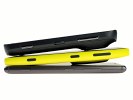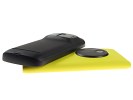From the full article:
Nokia has been the king of cameraphones since the golden days of Symbian. The legendary Nokia N95 won our first 5 megapixel shootout, and it was shortly followed by the N82, which added a xenon flash to the mix. Symbian's fate then took a sharp turn for the worse, but even so, the emblematic sharpshooter Nokia N8 came along. Then, at the end of the Symbian era, the 808 PureView arrived and changed our understanding and expectations of cameraphones for good.
Unfortunately for the Finns, their WP8 cameraphone voyage didn't begin as smoothly as the Symbian journey ended. The Lumia 800 had an interesting multi-aspect sensor, which sacrificed only little resolution when shooting 16:9 stills, while the Lumia 920 was first to bring optical image stabilization (OIS) to the smartphone world, but neither of those was able to achieve the iconic status of their predecessors. Perhaps adding the PureView moniker to the Lumia 920 in an attempt to capitalize on the brand was a mistake by Nokia, as that guaranteed the smartphone will often be compared to the 808 PureView and that was a battle it was never going to win, OIS or not.
People wanted their 41MP WP8 smartphone and yesterday Nokia finally delivered.
The Windows Phone ecosystem is still growing but not fast enough to compete with the big boys. Perhaps bringing the platform to the forefront of the cameraphone race is exactly the kind of push it needed. And camera aside, the Lumia 1020 delivers duly on all those vital other aspects of a modern-day smartphones with barely any compromises made - check out the complete breakdown below.
Phrases like 'finally delivered' and 'barely any compromises' summarise the positive feeling the Lumia 1020 has engendered across the blogosphere in the last few days. Listen to Rafe's hands-on impressions in our podcast that was published yesterday for more.
On the other hand, the Lumia 1020 has the same footprint as its predecessor, the Lumia 920 (130.3 x 70.8 x 10.7 mm) and is even slimmer than it if you don't count the bulge for the camera. The comparison with the 13.9mm thick 808 PureView is also favorable for the Lumia 1020. Granted the original PureView handset had a larger sensor, which means much larger camera module, but the Lumia 1020 has a brighter F/2.2 lens and OIS and both of these require quite a lot of room.



Nokia Lumia 1020 sized up against the 808 PureView and the Lumia 925The weight of 158g is easily felt when you hold the Nokia Lumia 1020 in your hand or in your pocket, but it's still better than the 185g Lumia 920 or the 169g 808 PureView.
Certainly the Lumia 1020 came in quite a bit thinner than most pundits were predicting, including me. Early indications had been that Nokia might go for a 20MB sensor to keep the camera depth down, but it seems that a wide angle solution with slightly smaller (well, 50% smaller, if you do the maths) sensor was enough to keep the thickness manageable. I'm liking the materials used in the 1020 too, with the metal camera island.
As far as image quality is concerned, the Lumia 1020 display performs excellently - it has good brightness levels for an AMOLED screen and excellent viewing angles. Blacks as typical for the technology are as deep as they get.
Display test 50% brightness 100% brightness Black, cd/m2 White, cd/m2 Contrast ratio Black, cd/m2 White, cd/m2 Contrast ratio Nokia Lumia 1020 0 172 ∞ 0 398 ∞ Nokia Lumia 920 - - - 0.48 513 1065 HTC One 0.13 205 1580 0.42 647 1541 Samsung Galaxy S4 0 201 ∞ 0 404 ∞ Apple iPhone 5 0.13 200 1490 0.48 640 1320
Sunlight legibility is pretty decent, although not exactly as great as on the 808 PureView and its much brighter AMOLED screen.
Nokia's Clear Black Display is now fairly widespread and in every single test I do puts Nokia phones ahead of the competition when it comes to seeing the screen outdoors. The Nokia 808's original high score on GSM Arena for sunlight performance was possibly a blip, mind you, as it seems soooo far ahead. Or maybe the lower pixel count actually helps clarity when outdoors?
Certainly, the only cameraphone that can come close to the Lumia 1020 output is the Nokia 808 PureView with its even larger sensor. As we already mentioned we compared those two side by side and found that Nokia has slightly altered the processing algorithms in its new cameraphone flagship.
Unlike the 808 PureView, which delivered natural colors that are as close to reality as we've seen any smartphone get, the Lumia 1020 goes for boosted saturation and warmer colors. We suspect this has a lot to do with the former head of Nokia imaging Damian Dinning leaving the company. Mr Dinning was a fan of more natural unprocessed look and most Nokia smartphones developed under his lead reflected that.
Now the Lumia 1020 takes a different path and goes for the punchier output even if that means sacrificing some detail. The saturation boost has cost the Lumia 1020 some fine detail, which is still present on the 808 PureView shots. We really hope Nokia tunes down the default saturation in the final product as those who like more vibrant colors can always boost the saturation from the camera settings.
Now that's an interesting (and plausible) theory. As noted even today in my 808 vs S4 Zoom shootout, the Nokia 808's camera does produce results which are incredibly 'natural', whereas results from most consumer smartphone cameras tend to look as if they've been processed - which, of course, they have. However, most consumers, when faced with a choice, will nearly always plump for something with more colour and higher sharpness - even if both weren't there in the original scene!
Good stuff, though. I wonder when we'll be able to get a Lumia 1020 in the 'All About' office? Not that we're jealous.....!
